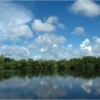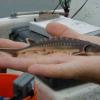In my pond, which is just about a quarter acre and 8-10 feet deep at most, I have a real boom bust cycle with them. Seems like tens of thousands winter kill. Then up until July, I don't notice too terribly many. But by the end of fall there are once again tens of thousands. I notice this here in may bodies of water. Maybe because they are introduced and came originally from a southern population? Or is this just their natural cycle? Might make sense? Fewer adults to prey on their offspring, would make for a higher survival rate, right? So winter kill would take the least cold tolerant or simply the weakest each year, and the high genetic turnover would provide for rapid adaptation making them invasive in their own backyard, as they seem to be.











